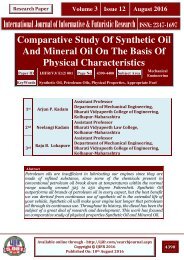IJIFR VOLUME 3 ISSUE 12 AUGUST 2016
RESEARCH PAPER
RESEARCH PAPER
Create successful ePaper yourself
Turn your PDF publications into a flip-book with our unique Google optimized e-Paper software.
ISSN: 2347-1697<br />
International Journal of Informative & Futuristic Research (<strong>IJIFR</strong>)<br />
Volume - 3, Issue -<strong>12</strong>, August <strong>2016</strong><br />
Continuous 36 th Edition, Page No: 4537-4550<br />
1. INTRODUCTION<br />
In recent years, polymeric based composite materials are finding increasing use in many<br />
applications due to their strength, lightness, ease of processing, high wear resistance and<br />
low-cost. Properties of composites are not only dependent on the properties of their<br />
constituent materials, but also their distribution and the interaction among them. They are<br />
widely used in many industrial applications such as structural, aerospace, automobile and<br />
chemical. Addition of fillers in polymeric composite enhances mechanical, tribological and<br />
other properties and also there is a cost reduction in terms of consumption of resin<br />
material.The critical and final selection of filler primarily depends upon the requirements of<br />
the end products.A literature survey indicated that the addition of tungsten disulphide as a<br />
filler with 4 microns size is thoroughly mixed with epoxy resin in seven different volume<br />
percentages by simple mechanical stirring. The investigation studied by J. S. Sidhu et. al. [1]<br />
led to the conclusion that Polymer composites suitable for Engineering components<br />
subjected to wearing environments can be successfully prepared by filling in micro WS 2 .<br />
Research work in the field of mechanical properties of the polymer dominated by<br />
Srivastavaet. al. [2]showed thatthe fracture toughnessof epoxy resin could be improved by<br />
fly ash particles as fillers. The fillers affect the tensile properties according to their packing<br />
characteristics, size and interfacial bonding. The maximum volumetric packing fraction of<br />
filler reflects the size distribution and shape of the particles. Lingarajuet. al. [3] studied the<br />
mechanical properties of fiber-reinforced composite, which showed improvement by the<br />
inclusion of nanoparticles. Addition of 1%wt. of silica showed improvement in impact<br />
strength, tensile strength, Barcol hardness and reduction in wear rate. Ricardo Baptistaet. al.<br />
[4] studied the effect of the incorporation of different amounts of graphite filler on the<br />
mechanical properties of epoxy resin and of carbon fiber reinforced epoxy composites.<br />
Graphite-reinforced epoxy resin attained results show that 7.5, 10 and 11.5 wt.%-graphite<br />
results in the best balance of mechanical (modulus, strength, strain) properties and that the<br />
incorporation of graphite as matrix filler in carbon fiber reinforced epoxy results in<br />
improvement on mechanical properties, up to a limiting value. S.Pichi Reddy et. al. [5]<br />
investigated tensile and flexural behavior of fly ash reinforced glass fiber epoxy composites<br />
with different weight percent of fly ash. The results showed that with increase of fly ash<br />
better tensile strength is obtained and flexural strength decreases, reaches a maximum value<br />
and again decreases with the addition of fly ash in the epoxy matrix. Manoj Singla and<br />
Vikas Chawla [6] investigated the Mechanical Properties of Epoxy Resin – Fly Ash<br />
Composite with the addition of fly ash and then by reinforcing glass fiber. With the addition<br />
of fly-ash in epoxy resin –fly-ash composite the compressive strength has been found to<br />
increase with increase in fly ash particles and after reinforcing glass fiber both compressive<br />
& impact strength has been increased. J.M. Wernik, S.A. Meguid [7] investigated the<br />
mechanical properties of carbon nanotube reinforced epoxy adhesives experimentally. The<br />
experimental observations indicate a critical carbon nanotube concentration in the vicinity<br />
of 1.5wt% that results in the largest improvements in the mechanical properties. At<br />
concentrations exceeding this critical value, the properties begin to degrade, in some cases,<br />
Karle Anuja H., Giri Pooja P, J. S. Sidhu:: Investigation Of<br />
Mechanical And Tribological Behaviour of WS2 & ZrO2<br />
Filled Epoxy Composites<br />
4538



